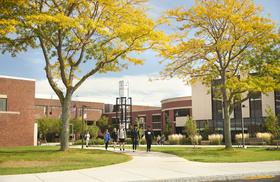According to a recent press release from the College Board, the cost of college courses during the 2008-2009 school year did not rise faster than the Consumer Price Index. As reporter Kim Clark from the US News and Report reports, “In the academic year starting in the fall of 2008, for the first time in six years, most college prices rose by less than inflation. Even better: After subtracting out the typical amount of scholarships and tax breaks, the average community college student paid only $101 for a year's worth of classes, down from $122 last year.”
Although the dwindling economy poses new struggles for academic institutions and students, the silver lining may be seen more clearly as the analysis of tuition hikes and the rate of inflation is evaluated.
This video reports on one student's experience with attending community college for free.
How to Handle Potential Tuition Increases
Investigating Reports
Although the rise in college costs poses challenges to students and families, Gaston Caperton, the College Board President, asserts that understanding “information in the trends reports will help families to make better educational decisions.” As Gaston further reveals, “‘A college education is the passport to opportunity and success in today’s global economy. In this time of financial uncertainty, it is essential that students and families have the most up-to-date information on the true costs associated with making this important investment in their future.’”
Caperton advocates that families should review and evaluate information in the College Board publication “Trends in College Pricing 2008,” as the trends report will help inform individuals and families with greater details regarding issues of higher education costs, tuition increases, inflation rates, and available aid.
In further examining the College Board’s “Trends in College Pricing 2008,” students and families will quickly learn that colleges across the country did raise their tuition costs. Upon investigating the report, however, readers will learn that while there was an increase in tuition costs, after adjusting for a 5.6% Consumer Price Index, the community college costs across the country actually declined by a total average of 0.8% for two-year colleges.
Adding to this, when adjusting for the Consumer Price Index, reports further reveal that two-year community colleges actually declined in cost while four-year institutions and university costs rose nearly 0.7 percent. Essentially, by learning the facts of tuition, inflation, and the economy, many students may discover that the financial conveniences and decreased costs of community college courses may be more accessible and realistic than the higher-priced university programs.
This video reports on the tuition-free program in California's community colleges.
Finding Financial Aid
While tuition increases remain generally below inflation rates, students are still seeking out means for financial assistance and support. As a rising number of students enroll in community college schools, a greater number of students are applying for loans to help ease the pain of tuition increases.
As the number of students applying for loans increases, however, private loan vendors have unfortunately been forced to decrease their available loan amounts. As the College Board reports, during the 2007 to 2008 school year, “the private loan volume actually declined by $173 million (1 percent) to $19.1 billion in 2007 dollars. That decline reversed years of double-digit growth and came before the current credit crisis brought on new concerns about students’ ability to find loans.”
Despite this downward loan shift, the College Board further reveals that students can find assistance. While the costs of some higher educational institutions have increased in the past several years, students still have a great abundance of financial aid resources to help ease the burden of tuition costs. As the Board asserts, “Financial aid, including both grants and federal loans, increased in 2007-08 by a per-student average of 5.5 percent after adjusting for inflation, according to the most recent aid data available.” With this increase in financial aid, many schools can actually utilize the rising aid funds to lower the net price that students are required to pay for college courses.
Further supporting this concept, Sandy Baum, the College Board’s senior policy analyst and professor of economics at Skidmore College, asserts: “‘Adequate and accessible financial aid is now more crucial than ever with so many students and families facing a wide range of economic pressures. These new reports provide important information not just for students and families, but for colleges and universities, as well as policymakers trying to assure that quality higher education is financially accessible to all qualified students.’”
While aid is certainly beneficial, The US News and Report further asserts that “Those who got no aid at all paid an average of $2,404 a year, up 4.7 percent from 2007, which was less than the 5.6 percent increase in the consumer price index.” Essentially, while tuition costs appear to soar, the costs are still generally manageable. Further according to the US News and Report, “Since almost half of the approximately 21.6 million Americans who take at least one college class a year attend community college, that means nearly 10 million Americans are still getting education bargains.”
Adding to this, financial aid experts currently state that, despite economic troubles, approximately half of all college students will receive, at the very least, some form of free money from scholarships and/or aid to help fund the costs of education and classes.
Questions? Contact us on Facebook. @communitycollegereview















